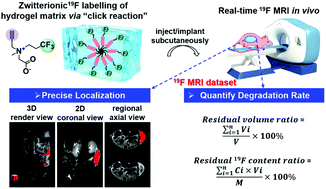19F magnetic resonance imaging enabled real-time, non-invasive and precise localization and quantification of the degradation rate of hydrogel scaffolds in vivo†
Abstract
The degradation behavior of hydrogel scaffolds is closely related to the controlled release of bioactive agents and matching with the proliferative demands of newly generated tissues. However, the current methods cannot provide precise localization and track the degradation of individual hydrogel scaffolds in vivo, despite superficial or volumetric information. Here, for the first time, we presented the use of 19F magnetic resonance imaging (19F MRI) to precisely monitor the localization and quantify the degradation rate of implantable or injectable hydrogels in a real-time and noninvasive manner, with no interference of endogenous background signals and limitation of penetration depth. The total voxel and content in the region of interest (ROI) were linearly correlated to the injection amount, providing exact three-dimensional (3D) stereoscopic and two-dimensional (2D) anatomical information in the meantime. Moreover, a computational algorithm was established to present the real-time degradation rate in vivo as a function of time, which was implemented directly from the 19F MRI dataset. In addition, labelling with a zwitterionic 19F contrast agent demonstrated a facile and general applicability for multiple types of materials with no influence on their original gelation properties as well as 19F NMR properties in the hydrogel matrix. Therefore, this 19F MRI method offers a new approach to non-invasively track the degradation rate of hydrogel scaffolds in vivo in a precise localization and accurate quantification way, which will suffice the need for the evaluation of implants at deep depths in large animals or human objects.



 Please wait while we load your content...
Please wait while we load your content...